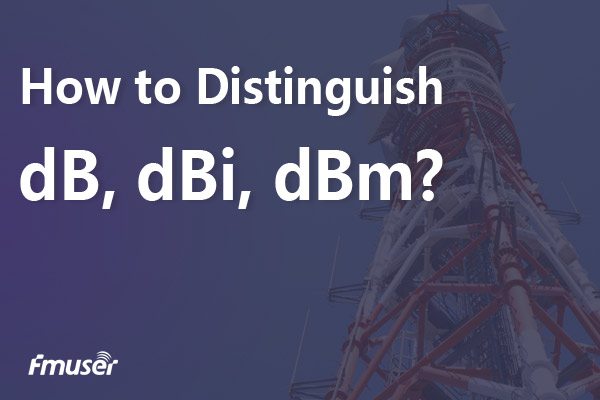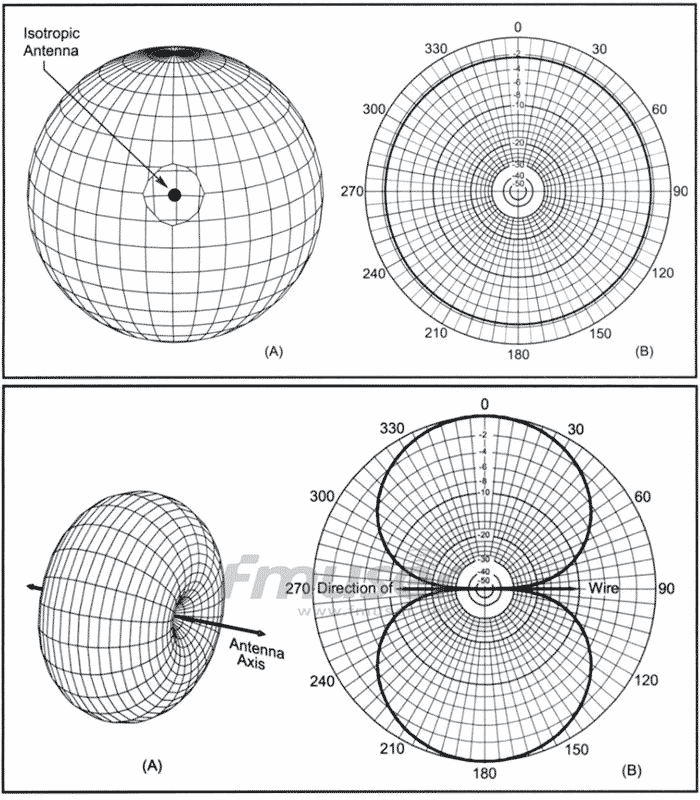
Hot tag
Popular search
How to Distinguish dB, dBi and dBm? | FMUSER Broadcast

If you have worked in the radio broadcasting industry for a period of time, you must have seen these units marked on some manuals of some radio broadcasting equipment like FM antenna or RF amplifier: dB, dBi, dBm. They look similar, but do you know what they mean and how to distinguish them? After reading this article, you will know their meaning and how to distinguish them.
Content
The Definition of Gain
Before getting to the point, let's answer two questions: what does the gain of an FM broadcasting antenna mean?
Based on Wikipedia, in a transmitting antenna, the gain describes how well the antenna converts input power into radio waves headed in a specified direction. In a receiving antenna, the gain describes how well the antenna converts radio waves arriving from a specified direction into electrical power. When no direction is specified, the gain is understood to refer to the peak value of the gain, the gain in the direction of the antenna's main lobe.
In short, the FM antenna can not improve the power of the transmitting device or the receiving device itself, but the antenna can concentrate these power or radio waves in a specified direction. In this way, the radio wave intensity emitted by the antenna in this direction will be stronger than the original one, which also means that the radio wave intensity in other directions will be weaker than the original one. So the gain is the ratio of the radio wave intensity in the direction with the strongest radiation intensity to the original radio wave intensity.

Different Gain of Isotropic Antenna and High Gain Antenna
Definition and Differences of dB, dBi and dBm
After having a basic understanding of the concept of gain, it is much easier to understand the three units of dB, dBi, and dBm.
The Definition of dB
We learned in school that dB represents the loudness of sound. However, it is different in the RF field. Its formula is dB=10log(x/y)(where x and Y represent the radiation intensity of the two antennas) and represents the difference between the power levels of the two antennas(gain or loss)
Via calculating, we can know that if x is weaker than y, dB is negative; When x and y are equal, dB is equal to 0; When x = 2y, dB is equal to 3. Similarly, 6dB means x is equal to 4 times y and 12dB means x is equal to 16 times y. It should be noted that if you want to measure the actual gain or actual power difference of the wired antenna, please consider the loss of the RF cable itself.
The Definition of dBi
If you want to compare the radiation intensity of the gain directional antenna and omnidirectional antenna, you should take dBi as the unit, where "i" represents isotopic, and the calculation formula of dBi is the same as that of dBi
Because the omnidirectional antenna will radiate the radio signal with a perfect "sphere", that is, it has the same radio intensity in each direction. When the antenna has a gain in a specified direction, its lobe will narrow, that is, the FM radio station antenna takes a certain angle as the main radiation direction, and the radiation intensity is stronger than the original radiation intensity. The ratio of the radiation intensity of this main radiation angle to the original radiation intensity is the gain of this directional antenna. Therefore, when dBi is larger than 0, it indicates that the antenna has directivity.

The Radiation Pattern of an Isotropic Antenna
The Definition of dBm
Although dBm looks like dBi, it does not represent the radiation intensity. The "m" in dBm represents milliwatts (MW), which is similar to dBi, it is also a relative value, but it represents the relative value of transmission power with 1MW as the reference value. The formula is: dBm = 10 log (P1/1MW)
Although dBm is a relative value, it can be converted into the actual power of the equipment after unit conversion. For example, 0dbm = 1MW, 1dbm = 1.3MW, 10dBm = 1W, 60dbm = 1000W... It can be seen that it can use very simple values to represent very small power or very large power. Therefore, the actual power of various devices will be expressed in dBm.
| Watt to dBm Conversion Table | |
| Power (watt) | Power (dBm) |
| 0.00001 W | -20 dBm |
| 0.0001 W | -10 d Bm |
| 0.001 W | 0 dBm |
| 0.01 W | 10 dBm |
| 0.1 W | 20 dBm |
| 1 W | 30 dBm |
| 10 W | 40 dBm |
| 100 W | 50 dBm |
| 1000 W | 60 dBm |
The Differences among dB, dBi and dBm
In summary, dB, dBm, and dBm all are relative values, but they have the following 2 differences:
- The dB and dBi are used to represent the relative intensity (gain or loss) of the radio radiation of the antenna, while dBm is used to represent the actual power of the equipment.
- The dB is the relative value of the radiation intensity difference between two antennas, and dBi is the radio signal strength comparison of an antenna before and after gain (or orientation).
Frequently Asked Questions
1. Q: What is dB Gain for an FM Broadcast Antenna?
A: It is the ability to radiate more or less in a direction for FM Broadcast Antennas.
The dB is measured by the ratio of power, current or voltage of two signals. It is the most commonly used unit for gain.
2. Q: Why the Signal Strength is Measured by dB?
A: Because the signal strength varies logarithmically but not linearly.
We use dB to measure the signal strength because signal strengths vary logarithmically, not linearly. A logarithmic scale allows simple numbers to represent large changes in signal levels.
3. Q: What does the -3 dB Gain Mean for the Antenna?
A: -3dB gain means the output gain is reduced to 70.71% of its maximum level.
The -3dB gain point define the output gain level is reduced to 70.71% of its maximum level. Or we can say that the -3dB point is also the frequency at which the gain of the system has reduced to 0.707 of its maximum value.
4. Q: Is Higher dBi Better than the Lower One?
A: Of course not, everything coin has two sides. Higher dBi means radiating further but narrower.
The higher the dBi number of the antenna, the higher the gain it has, but less of a broad field pattern. It means that the signal strength will go further but in a narrower direction. If you want to radiate a wider direction, you need to add more antennas.
Conclusion
We learn the definitions and differences of dB, dBi, and dBm through the above content. It is quite helpful for you to know the antenna theory better before entering into RF field. If you want to know more about broadcasting, or you need any radio broadcasting equipment for sale, please feel free to contact our RF expert team, you will be replied as soon as possible. And don't forget to share this blog if it is helpful to you!
Also Read
Tags
Contents
Related Articles
CONTACT US


FMUSER INTERNATIONAL GROUP LIMITED.
We are always providing our customers with reliable products and considerate services.
If you would like to keep touch with us directly, please go to contact us





